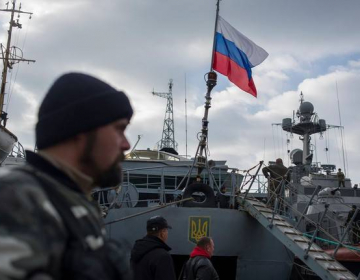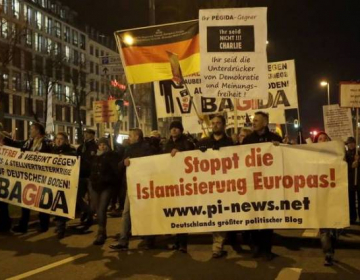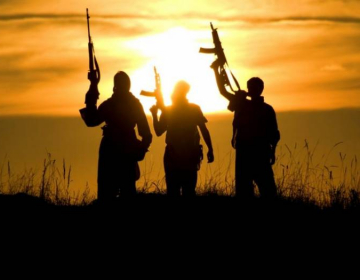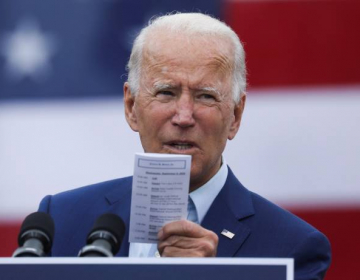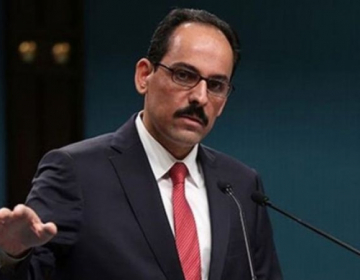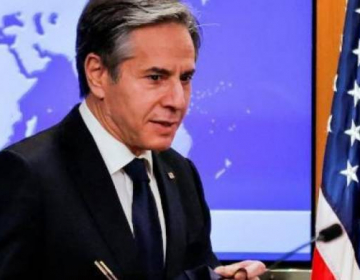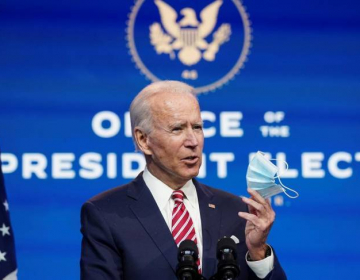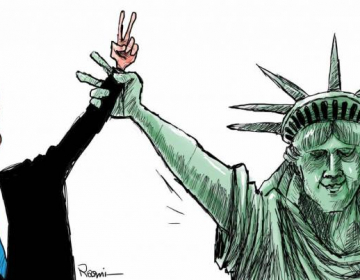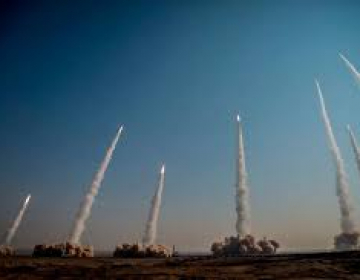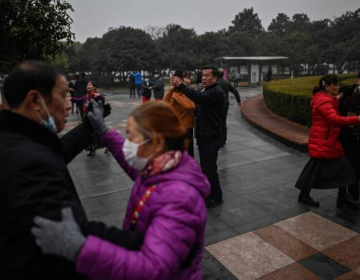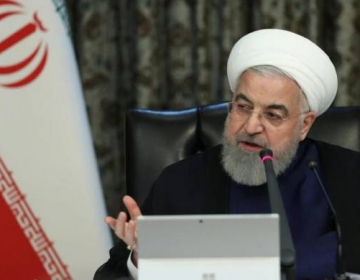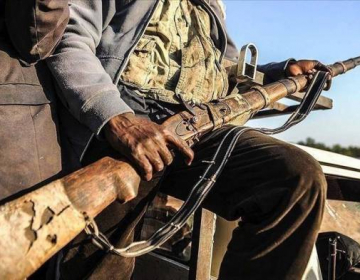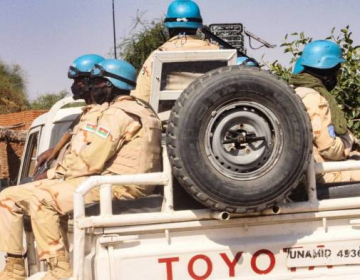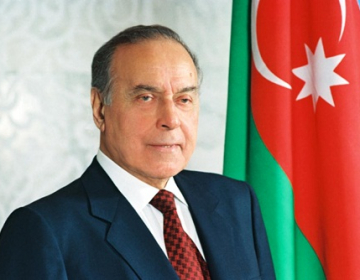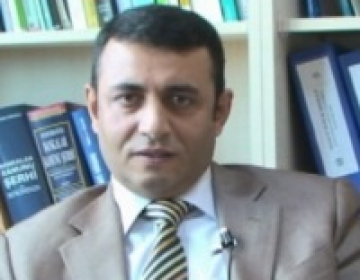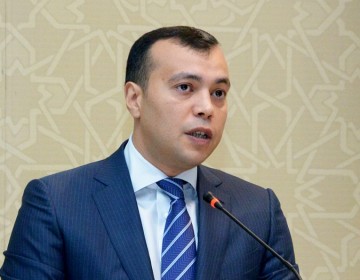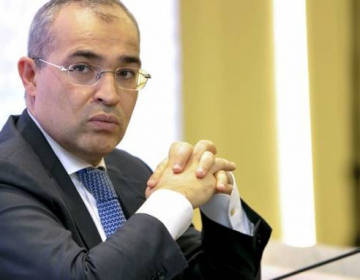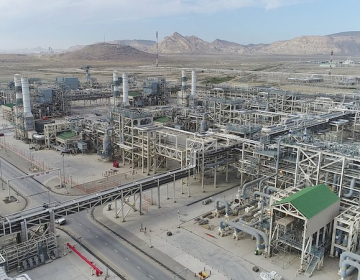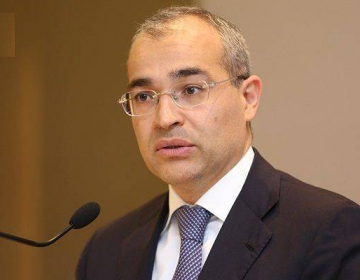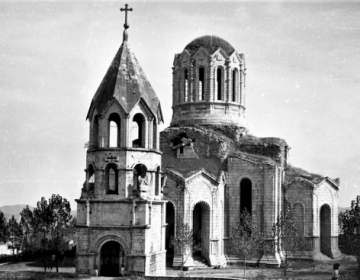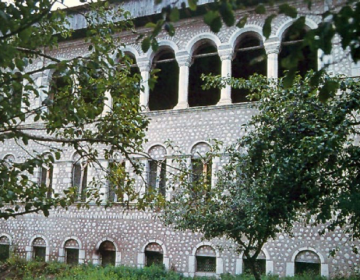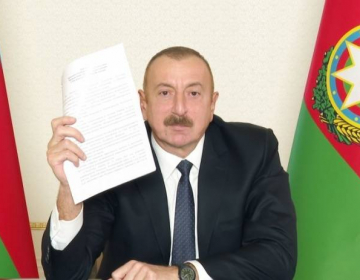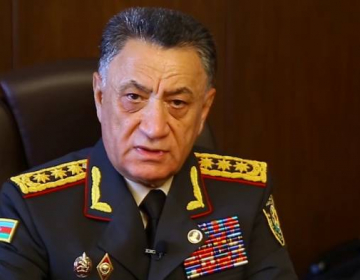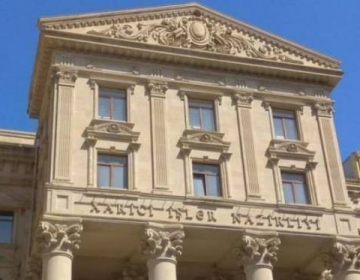Restoring America’s Geostrategic Approach
Michael Doran
Michael Doran is Director of the Center for Peace and Security in the Middle East at the Hudson Institute and a Senior Fellow at the Hudson Institute. He is a former Senior Director in the U.S. National Security Council, Senior Advisor in the U.S. State Department, and a Deputy Assistant Secretary of Defense of the United States. The views expressed in this essay are his own.
Azerbaijan is “geopolitically critical” to the United States, argues the 1997 book, The Grand Chessboard, by Zbigniew Brzezinski, the national security advisor to former President Jimmy Carter. Counterbalancing Russia is a primary duty of the United States, and the mere placement of Azerbaijan on the map makes it a crucial partner in that effort. The benefits of partnership extend well beyond Azerbaijan’s immediate neighborhood, the South Caucasus. The country is the sole gateway to the West of the former Soviet states of Central Asia. The independence of those states, Brzezinski explains, “can be rendered nearly meaningless if Azerbaijan becomes fully subordinated to Moscow’s control.”
Brzezinski was not alone in championing this view. In the late 1990s and early 2000s, American foreign policy professionals on both sides of the political aisle espoused the same perspective, which we shall dub the “the geostrategic approach.” Its influence generated significant American support for the creation of an East‑West land bridge, across which rail tracks and energy pipelines now stretch—the Silk Road region’s only terrestrial supply lines from Asia to Europe that Russia cannot control. This land bridge opened the way for an air corridor which, during the war in Afghanistan, allowed planes from America’s military bases in the Middle East to reach the battlefield by a route much shorter than any alternative, and one that required no haggling with difficult partners, such as Russia.
As it emerged defeated three decades ago from the First Karabakh War (1988‑1994), Azerbaijan was virtually a failed state, inundated with hundreds of thousands of refugees and internally displaced persons. Today it is the wealthiest, most prosperous, and most influential country in its neighborhood. Its victory in the 2020 Second Karabakh War also revealed the startling power of its military. The rise of Azerbaijan has vindicated Brzezinski and his cohort, but even as the country grows stronger and fulfills the role envisioned for it, the geostrategic approach grows weaker. Supporters of this perspective in Washington today are few and far between. Are we witnessing the temporary eclipse of an influential foreign policy doctrine, or its total demise?
The Struggle for Eurasia
Before answering that question, let us stipulate that the decline of the geostrategic approach is part of a larger American retreat from the Middle East and Central Asia, which is the result of five major developments:
One, domestic legitimacy crisis. The geostrategic approach is a victim of the ongoing political polarization in the United States. In Washington today, foreign policy doctrines rise and fall according to whether they advance domestic political agendas. As a nonpartisan reading of the national interest, the geostrategic approach serves no clear domestic master—while even riling up several influential domestic lobbies— and therefore offers its champions few rewards.
Two, the rise of Sino‑centrism. American foreign policy today focuses on East Asia, with Taiwan in the center of the frame. What is the place of the South Caucasus in the struggle for Taiwan? To ask the question is to answer it.
Three, the dictates of “Restraintism.” In both parties, significant constituencies call for a restrained foreign policy, one that avoids not just conflict but involvement in far flung regions. The geostrategic approach, however, urges the United States to get deeply involved in an unfamiliar corner of the world, some six or seven thousand kilometers from home.
Four, the Iran gambit. Following the example of the Obama Administration, the Biden Administration is searching for a modus vivendi with Iran, not just with respect to the nuclear question but with respect to regional order as well. The gambit, which plays well among progressives in America, seeks to end the contest with Iran so as to facilitate the pivot to Asia. Tilting toward Azerbaijan, in many ways Iran’s natural rival, does not comport with a policy of accommodating Tehran.
Five, the disaffection with Turkey. A prolonged crisis, the worst in 50 years, has beset U.S.‑Turkish relations. As Turkey’s closest ally, Azerbaijan has been caught in the crossfire.
Taken together, these developments establish the grounds for arguing, with some force, that the geostrategic approach is in fact dead. Having said that, news of its demise may yet be premature. It is not hard to imagine scenarios in the future—highly plausible scenarios—that will lead to a resuscitation of the doctrine.
Consider, for example, the growing support among Americans for the following four assertions. One: Russian leader Vladimir Putin’s “imperial” project has more vitality than many analysts originally assumed. By hook or by crook, he aims to bring the countries of the former Soviet Union into some sort of formalized Russian sphere of interest.
Two: Chinese leader Xi Jinping seeks not just to take control of Taiwan but to transform the global international system, replacing it with a Sinocentric order, downgrading America in the process.
Three: Iranian Supreme Leader Ali Khamenei will never accept a deal on Iran’s nuclear program that will truly block all pathways to a bomb, nor will he reach lasting agreements on regional security with the United States. Like Putin and Xi, Khamenei seeks to overturn the American‑led international order.
Four: China, Russia, and Iran are increasingly c o o p e r a t i n g among themselves on projects of mutual interest; when not cooperating, they are often moving along roughly parallel lines. Although their interests do collide in some areas, they share the same grand strategic goal of weakening America and its allies.
As these four propositions become increasingly obvious to the American electorate, it is easy to imagine shocks to the American‑led international system—such as an attack on Taiwan by China, on Ukraine by Russia, or on Israel by Iran—that will force the strategic community in Washington to conclude that the United States faces a loose global coalition of revisionist powers whose collective goal is to topple America from its position of primacy in Eurasia.
As it develops a strategy for winning the struggle for Eurasia, Washington will soon rediscover the set of unique characteristics that make Azerbaijan a prime candidate for a special partnership.
Indeed, as the United States retreats, China, Russia, and Iran are growing more, not less assertive. This dynamic means one of two things. Either America’s decline will entail a series of ignominious collapses on the model of the withdrawal from A f g h a n i s t a n , leading ultimately to the loss of its status as the preeminent world power; or Washington will manage its decline better, by discovering a method for checking its rivals with as little reliance as possible on its own military. Since the days of Thucydides, great powers have had recourse to only one such method: borrowing the power of allies and partners. As it develops a strategy for winning the struggle for Eurasia, Washington will soon rediscover the set of unique characteristics that make Azerbaijan a prime candidate for a special partnership.
Nationalism
The geostrategic approach calls for paying close attention not just to the character of states and the policies of governments but also to the tectonic plates atop which those rest— plates formed over the centuries by history, demography, and culture. Seen through this prism, one of the most important attributes recommending Azerbaijan for strategic partnership with the United States is the simple and obvious fact that it is a real nation state and not what is often called by specialists an “imagined community.” Its government represents a cohesive society held together by a strong communal identity. Unlike many post‑Soviet and Middle Eastern states, Azerbaijan is not a collection of diverse ethnic groups that, thanks to accidents of history and the whims of imperial cartographers, woke one day to find themselves living under the same government.
The geostrategic approach calls for paying close attention not just to the character of states and the policies of governments but also to the tectonic plates atop which those rest—plates formed over the centuries by history, demography, and culture.
This does not mean that there are no minorities in Azerbaijan— only that they are, in fact, actual minorities, whose size does not fragment the country politically or undermine its security. Their status as full and respected members of the state is beyond doubt. The Western press frequently depicts the conflict with Armenia as a sectarian struggle pitting Muslimmajority Azerbaijan against one of its Christian neighbors, but it is more accurately understood as a contest between rival nationalisms. The tolerance of Azerbaijani society is well documented in general but affirmed specifically by the self‑assurance of the Jewish community, which has existed continuously for many centuries—possibly for over 2,000 years—harmoniously integrated into the country’s social and cultural life. All Azerbaijanis are familiar with the battlefield sacrifice of Albert Agarunov, a Jewish hero of the First Karabakh War. In downtown Baku, a statue stands in his honor.
Azerbaijan’s identity places it in a state of permanent enmity with Iran. Leaders on both sides have a strong interest in keeping the enmity contained. When Azerbaijani and Iranian officials meet, smiles break out and affirmations of brotherhood flow freely. Beneath the niceties, however, boundless suspicions lurk—because Baku and Tehran sit on opposite sides of not one, but two socio‑historic fault lines.
The first of these is the line between the Persian and Azerbaijani nations. After a series of wars between the Russian Empire and Iran, the treaties of Gulistan (1813) and Turkmenchay (1828) forced Iran to cede the South Caucasus—that is, the lands north of the Aras River—to Russia. This border, drawn by two multiethnic empires, bisected the lands populated by ethnic‑Azerbaijanis, the people whom Azerbaijani nationalists today call “the Azerbaijani nation.” Ethnic‑Azerbaijanis constitute between one‑fifth and onethird of the entire population of the Islamic Republic of Iran, and they are predominantly concentrated in ethnically homogenous communities located in the regions immediately south of the Aras River. Historically, they have been well integrated into Iran, including at the highest levels of political and economic life. Many feel themselves to be Iranian first and Azerbaijani second.
But some significant portion, especially of the younger generation, feels less loyalty to its Iranian identity and longs to cultivate its Azerbaijani roots. Among Azerbaijanis living in the Persian heartland, intermarriage and assimilation rates are high, but among those living in predominantly ethnic‑Azerbaijani provinces, a desire for greater cultural rights is increasingly evident. Those provinces are consumers of Turkish and Azerbaijani m e d i a — w h i c h promote a very different picture of the relationship between religion and state than prevails in the Islamic Republic. Though a Muslim majority country, Azerbaijan is a secular state and Western in its cultural orientation, with women fully integrated in public life and alcohol consumed at European levels.
Azerbaijani Iranians have watched with ever growing pride as an independent Azerbaijani state rose from the ashes after the First Karabakh War. They find the quality of life in Azerbaijan, which is much higher than in Iran, inherently attractive, and Azerbaijan’s historic victory in last year’s Second Karabakh War filled their hearts with joy and swelled their chests with pride.
To be sure, the war boosted nationalist sentiment in “South Azerbaijan,” as the nationalists call the Azerbaijani regions of Iran. But how deep does this sentiment run? Is it strong enough to fuel a movement for a federal state? Could it give rise to serious demands for an autonomous Azerbaijani region? Can the enemies of the Islamic Republic harness the sentiment for r e v o l u t i o n a r y ends? Or will it simply play out like the Iranian equivalent of Quebecois nationalism—strong enough to cause an occasional ruckus but not to drive events over the long haul? In a rapidly changing world, the answers to these questions are known to no one, but at the highest levels of the Iranian government they weigh heavily on the mind. A well‑organized movement for autonomy would shake the regime to its core.
The Azerbaijani question is therefore one of the most significant national security challenges—possibly even the most significant—that Tehran faces. Although the United States has been engaged in a contest with the Islamic Republic since 1979, Washington, historically, has shown scant awareness of the Azerbaijani question and, in turn, of the opportunity it offers for counterbalancing Iran and even for gaining leverage over it.
Not so Jerusalem. Israel’s ties to Baku are long and deep, and they include strategic cooperation, with Israel receiving around 40 percent of its oil from Azerbaijan, to which it sells high end military equipment, including some of the weapons and defensive systems that played a major role in Azerbaijan’s recent military victory. The Iranians, for their part, have long assumed that Azerbaijan is assisting Mossad, Israel’s intelligence agency, in its covert war against their nuclear program. In 2012, Mossad (presumably) assassinated Mostafa Ahmadi Roshan, an Iranian nuclear scientist. In response, Iranian officials lodged a formal protest with the Azerbaijani ambassador in Tehran.
The Azerbaijani question is therefore one of the most significant national security challenges—possibly even the most significant—that Tehran faces.
Was the protest based on solid information, or were the Iranians simply leaping to conclusions? We may never know for sure, but even the uncertainty surrounding the episode speaks volumes about just how unnerving Iran’s leaders find Azerbaijan. On the one hand, if Baku had been assisting Israel in its covert war, then the success of Mossad’s operation testified to the strength of Azerbaijan’s capabilities. On the other hand, if Baku had not been offering intelligence assistance to Israel, then Iran’s decision to lodge a protest with Azerbaijan’s ambassador reveals more than just a little paranoia.
To counterbalance its northern neighbor, Tehran has consistently supported Armenia in the conflict over Karabakh. Armenia is a Christian nation and Azerbaijan, like Iran, is a predominantly Shiite Muslim society. The ideology of the Islamic Republic calls for supporting fellow Muslims, but state interest trumps religious solidarity. In the Second Karabakh War, Tehran’s support for Armenia included one instance of direct intervention. Several diplomatic sources in Baku told me that, in mid‑October 2020, Iranian forces crossed the Khudafarin Bridge into Azerbaijan, where they placed concrete barriers on the road running parallel to the river. This action temporarily prevented reinforcements and supplies from reaching Azerbaijani frontline troops that had already moved westward past the bridge. The Iranians refused to budge for several days. They returned home only after Baku threatened to go public with its displeasure—a step that would have inflamed the sentiments of Azerbaijanis in Iran and turned them against their government.
Tehran also helped deliver military equipment and supplies to Armenia, which shares no border with its military patron, Russia. When Georgia barred Moscow from using its airspace, Tehran offered the Russians access to Armenia through Iran. Iranian Azerbaijanis, however, learned of the resupply operation. Protestors took to the streets in anger, forcing Iranian officials to deny that they were aiding Armenia and to issue affirmations of Muslim solidarity with brotherly Azerbaijan.
Iran and Turan
The second fault line separating Baku from Tehran is the divide between Iran and Turan. In Iranian literature, “Turan” refers to Central Asia. The word appears repeatedly in Iran’s national epic, The Shahname, written in the eleventh century by Ferdowsi, Iran’s poet laureate. The Shahname immortalized the fear that the Central Asian nomadic conquerors struck in the hearts of the settled Persians. “No earth is visible, no sea, no mountain, from the many blade‑wielders of the Turan horde,” writes Ferdowsi, who lived at the precise moment when the balance of power between Iran and Turan shifted in favor of the latter—shifted, more precisely, in favor of Turkic steppe warriors, the dominant group in Turan. Genghis Khan, the most famed steppe conqueror, was a Mongol, but his army was populated mainly by Turkic cavalrymen. Indeed, at that moment in history the most powerful militaries in the world were those fielding Turkic mounted archers. Tamerlane, the second greatest conqueror, was himself a Turkic horseman, and from his capital, Samarkand, he ruled all of Iran.
The second fault line separating Baku from Tehran is the divide between Iran and Turan.
Azerbaijanis are a Turkic people, the cultural descendants of steppe warriors. The era of Turkic military supremacy over Iran lasted about a thousand years. Political power brought demographic transformations. The region that now includes the Republic of Azerbaijan and the provinces of Iran populated by ethnic‑Azerbaijanis was completely Turkified. Demographic strength, in turn, brought political power. From the death of Ferdowsi down to World War I, almost every ruling dynasty in Iran emerged from Turkic tribes.
The greatest among them was Shah Ismail, the founder of the Safavid Dynasty, which built the most powerful and consequential Iranian state of the last millennium. Shah Ismail converted Iran to Shiism, and his power rivaled that of the Ottoman Empire. The Islamic Republic remembers him as a great “Persian” monarch, and the label is justified. But the Azerbaijanis also embrace him as a native son—and they, too, have a valid claim over both him and his legacy. Born to an Azerbaijani family in one Azerbaijani city, Ardabil, he made his capital in another, Tabriz. His troops were Turkic warriors, whom he spurred to battle with Azerbaijani poetry, which survives to this day, and which is regarded in Azerbaijan as a national treasure. In 1993, newly‑independent Azerbaijan erected a statue of him in downtown Baku.
Leaders in Tehran see Azerbaijan’s appropriation of great “Persians” such as Shah Ismail as the ludicrous pretensions of upstart yokels. The regime’s mouthpieces, official and unofficial alike, habitually paint Azerbaijan as a fake country, a trumped‑up former province of Iran that the Russians hived off from the motherland. The sense of superiority that these attitudes express is sincere, but it also masks more than a little insecurity. Fear of Turan will forever haunt the Persian collective consciousness—and not only because Turks dominated Persians for a thousand years. Leaders in Tehran today are haunted not by the ghosts of Turan past, but of Turan future.
On 10 December 2020, ghosts of the blade‑wielding horsemen of the Turan horde appeared in Baku. They were summoned by Turkish President Recep Tayyip Erdoğan, who joined Azerbaijani President Ilham Aliyev to celebrate the victory in the Second Karabakh War. From the podium, Erdoğan read a folk poem—a lament mourning the division of the Azerbaijani people by the Aras River. Iranian officials, for their part, interpreted this longing for unity as a grave threat to Iran’s territorial integrity and they exploded with rage. Among the many reactions was a signed statement by three‑quarters of the members of Iran’s parliament. Read out during a televised session, it “strongly condemned” Erdoğan’s remarks. Iran’s foreign ministry summoned the Turkish ambassador for a rebuke. “The Turkish ambassador was told that basing foreign policy on illusions is not wise,” Foreign Ministry spokesman Saeed Khatibzadeh tweeted.
Javad Zarif, the Iranian foreign minister at the time, also took to Twitter—to issue an empty threat. “Erdoğan was not informed” about the true meaning of the poem, he wrote. The lament was not about the Azerbaijanis being divided from one another, but about “the forcible separation” of Azerbaijan from the “Iranian motherland.” Didn’t Erdoğan realize that he was “undermining the sovereignty of the Republic of Azerbaijan?” Zarif asked. “NO ONE can talk about OUR beloved Azerbaijan,” he warned. Zarif was signaling that two can play at the game of reclaiming territory: Turkey and Azerbaijan should beware lest Iran decide to repatriate Azerbaijan.
But by turning a poem into a diplomatic incident, Zarif and his Iranian colleagues inadvertently exposed their impotence. Tehran played no role in shaping the war on its borders, and it was entirely shut out of the postwar diplomacy.
On none of Iran’s other borders is Tehran so utterly devoid of influence. However, by directing their rage at Erdoğan, they also revealed that the thing they fear most is not irredentism in Baku per se, but a larger Turanic movement led by Ankara. In contrast to Azerbaijan, Turkey is slightly more populous than Iran and wields much greater military might. It is a rising power, and it cannot be intimidated.
While the word “Turan” originated in Persian, it passed into Ottoman Turkish in the nineteenth century, becoming less geographic in meaning and more ethnographic. “Pan‑Turanism” now refers to the movement that sought to unite all Turkic peoples from the Ottoman Empire to Central Asia—from Istanbul to the Altai mountains.
For the most part, the Turkish Republic has shied away from pan‑Turanism, seeing it as a romantic idea, a movement of dreamers, inviting costly Turkish participation in pointless foreign adventures. But in recent years, a pan‑Turanist thread has appeared in Ankara’s policy, partly due to domestic politics in Turkey, partly to the abundant energy resources of Central Asia that must cross Turkey to reach Europe, partly due to the vacuum left by a retreating U.S.—and partly due to the success of the Turkish‑Azerbaijani alliance.
Among all the Turkic countries, Azerbaijan and Turkey are the closest, and their languages are mutually intelligible. When Turks and Azerbaijanis discuss their bilateral relations, they invariably mention the phrase, “One nation, two states.” This is no empty political slogan: in the popular cultures of both countries, expressions of mutual affection abound.
In the West, especially during the Second Karabakh War, many observers depicted this mutual affection and the military alliance it supports as a “jihadi” coalition, led by Erdoğan, the supposed Muslim Brother. This depiction is, not to mince words, laughably ignorant. The Turks are Sunnis. Turkish Islamists, therefore, regard the post‑Soviet Azerbaijanis as vodka‑swilling Shiites, a very disreputable type of person. Erdoğan wins no applause from the devout in Turkey when he embraces Ilham Aliyev. He does, however, win approval from secular nationalists, who are members of his domestic coalition.
But there are also other strands in the pan‑Turanist thread that Ankara has been lately weaving. Turkey has played the leading role in creating the Organization of Turkic States, whose members also include Azerbaijan, Kazakhstan, Kyrgyzstan, and Uzbekistan (with Hungary and Turkmenistan enjoying observer status). Founded in 2009 as the Turkic Council and headquartered in Istanbul, the organization is Turkey’s answer to China’s Shanghai Cooperation Organization and Russia’s Eurasian Union. It promotes cooperation among the governments of Turkic‑speaking countries, creating a club of states that, despite their many differences, share one thing in common: a desire to escape domination by larger powers, Russia and China above all others.
With no binding mechanisms for coordinating the economic and security policies of its members, the Organization of Turkic States does not currently pose a significant hard‑power threat to China and Russia. Like Iran, however, both those countries rule over Turkic Muslim minorities and therefore are extremely wary of Turkic solidarity, even if it comes in the form of a toothless organization. Events, moreover, are moving swiftly. The Second Karabakh War showcased the potential of Turkish unmanned combat aerial vehicles (that is, drones) to overwhelm Russian weapons system. Some influential voices in Turkey are now calling for closer security cooperation among the Turkic states. When the government of Kazakhstan followed Ukraine’s lead and signed a deal with Ankara, in November 2021, to acquire Turkish drones, Vladimir Putin and Xi Jinping cannot but have been displeased.
It is Ali Khamenei, however, who has the most to fear. In Tehran, the Second Karabakh War did more than just highlight Turkish military prowess. The ceasefire agreement requires Armenia to open a land bridge across its territory connecting Azerbaijan to its Nakhchivan exclave, which borders Turkey. This bridge, which the Turks and Azerbaijanis call the Zangezur Corridor, carries great symbolic meaning in pan‑Turanist circles. When it becomes operational, it will allow travel from Europe to China without ever leaving Turkic soil (except for the corridor through Armenia, which will be less than 50 kilometers long). The state of war for the last 30 years between Armenia and Azerbaijan ensured that no such direct rail or highway links could develop, although they existed in the Soviet, Russian, and Persian periods. Article 9 of the ceasefire agreement restores the lost connectivity. “The Republic of Armenia,” it states, “shall guarantee the security of transport connections between the western regions of the Republic of Azerbaijan and the Nakhchivan Autonomous Republic in order to arrange unobstructed movement of persons, vehicles, and cargo in both directions.”
This simple line is the stuff of nightmares in Tehran, where the Zangezur Corridor is seen as a pan‑Turanist plot—a land grab. Tehran fears that the “transport corridor” of today will morph into a security buffer tomorrow. It will interpose a joint TurkishAzerbaijani force between Iran and Armenia, cutting the two off from each other. Pan‑Turanist soldiers would then be arrayed all along the northwest frontier of Iran, poised to invade or to incite the millions of Azerbaijani Iranians living across the border, just a stone’s throw away. At the meeting of the Organization of Turkic States in November 2021, Ilham Aliyev did nothing to calm Iranian nerves. “The Zangezur Corridor,” he said, “will unite the entire Turkic world.”
Moscow’s “Special” Relationship with Baku
If Azerbaijan acts as a natural counterbalance to Iran, then its rise has also significantly eroded Russian influence in the South Caucasus and Central Asia. To untrained eyes in Washington, however, the veneer of warm and friendly relations between Moscow and Baku often makes the more lasting impression.
Entirely fluent in Russian and often schooled in Moscow, the Azerbaijani elite contains a sizeable contingent that promotes close ties with Putin. For his part, the Russian leader appears in no way anti‑Azerbaijani. During the Second Karabakh War, some observers even discerned a pro‑Azerbaijan inclination. For reasons that will become clear below, however, that description is a misreading of Putin’s approach. Nevertheless, it is based on some very real and startling aspects of Russian policy—most notably the military restraint that Russia exhibited even as Azerbaijan published, in the midst of the fighting, videos documenting the rout of the Armenian army and the destruction of state‑ofthe‑art Russian weaponry.
If Azerbaijan acts as a natural counterbalance to Iran, then its rise has also significantly eroded Russian influence in the South Caucasus and Central Asia.
To justify his restraint, Putin hid behind international law, which clearly recognizes that the territories occupied by Armenia in the First Karabakh War belong to Azerbaijan. This fact allowed him to claim that Russia’s treaty obligations only applied in the event of an attack on Armenia proper, not on Armenian forces in the occupied territories of Azerbaijan, which was where the fighting of the Second Karabakh war took place. On 22 October 2020, in the middle of the war, Putin appeared in a discussion organized by a Moscow think tank. When asked if the Kremlin’s special relationship with Yerevan would lead it to take Armenia’s side, he answered by depicting Russian policy as equally balanced between the belligerents. “Let’s start from the beginning, with […] whom to support,” Putin answered. “You said that Russia has always had special ties with Armenia. But we have always had special ties with Azerbaijan.”
When combined with Putin’s notoriously strained relations with Armenian Prime Minister Nikol Pashinyan, statements such as this strengthened the perception in Washington that Baku, not Yerevan, had won the contest for the Russian leader’s favor. The 2018 Velvet Revolution, Pashinyan’s populist reform movement, had already created a fertile soil for such perceptions to take root. It earned him high regard in the West and riled the Kremlin, especially when it led to the arrest of, among others, Robert Kocharyan, a former two‑term president and a close associate of Putin. Jailing Putin’s friends without permission is a cardinal sin of the new Russian order.
And sins will be punished. When the Second Karabakh War broke out, Putin used it to discipline Pashinyan—to remind him that, in Russian‑Armenian relations, it is Moscow that holds the whip hand. But that’s not all it holds. When the war ended, Putin had captured for Russia two prizes: the lead role in the diplomacy surrounding the conflict, and the job of keeping the peace on the ground with Russian troops— nearly 2,000 in total—which Baku has grudgingly accepted on Azerbaijani soil for the first time. Aliyev, for his part, raised no protests about Russia’s acquisition of these prizes.
Although these facts are entirely true, they paint a very misleading strategic picture, directing the eye to details which seem important on the surface, but which, upon close inspection, turn out to be irrelevant to American national security. Take, for example, the bad relations between Putin and Pashinyan. They certainly grab the eye, as contests between powerful personalities always do. With respect to the American interest, however, they are no more important than a soap opera, for one simple reason: they do not threaten the Russian military’s preeminent status in Armenia.
In Putin’s mind, Armenia is classified neither as a friend nor an ally, but as a satellite. This simple fact is often obscured in Washington, but it is an old story and one that by now should be obvious to all national security professionals. Shortly after the fall of the Soviet Union, leaders in Yerevan turned Armenia into the anchor of Russia in the South Caucasus. In the process, they placed the security apparatus of the country firmly and forever in Moscow’s hands. Russia is Armenia’s number one trading partner. Russians occupy the commanding heights of the Armenian economy, not to mention its rail network, gas lines, and nuclear power plant. More importantly, the Russian military operates two major bases in the country from which it supports a host of forward operating positions. Russian units routinely augment Armenian forces, including in border patrol duties. Whereas Azerbaijan must purchase its weapons from Russia, Armenia receives them for free or at a discount. The Russian military exercises total and direct control over Armenian airspace.
In Putin’s mind, Armenia is classified neither as a friend nor an ally, but as a satellite. This simple fact is often obscured in Washington, but it is an old story and one that by now should be obvious to all national security professionals.
It also controls Armenia’s arsenal of strategic weapons. Although this fact is crucially important for understanding the outcome of the Second Karabakh War, it has gone virtually unnoticed in the United States. During the conflict, the Armenian military launched one or more SS‑26 Iskander ballistic missiles at Baku. (There is some ambiguity in the source material over the number of missiles launched, with some credible sources suggesting that the number might be two or higher.) Moscow does not give the Armenian military independent launch authority over the SS‑26 Iskander.
Someone very high up in the Russian chain of command, possibly even Putin himself, approved the attack. In all likelihood, that person even encouraged or ordered it. We know from highly credible evidence, that the launch or launches occurred on 8 or 9 November 2020. The ceasefire agreement was signed by Armenia, Azerbaijan, and Russia late on 9 November 2020 and went into force on 10 November 2020. The launch or launches took place in the final hours of the war, while Putin was brokering the ceasefire. They were, that is to say, Putin’s main input into the negotiations.
A quick sketch of the situation on the battlefield reveals his motives. The Azerbaijani military had just executed a daring and successful surprise attack that drove the Armenians from the city of Shusha, the strategic prize for Azerbaijan, which towers over Stepanakert/Khankendi, the main ethnic‑Armenian‑populated city in Karabakh. The operation positioned the Azerbaijani military to drive all Armenian forces out of Karabakh in very short order. The Azerbaijanis, in other words, were but one day’s fighting away from total victory.
That was the context in which word was given to fire on Baku. Aliyev undoubtedly read the launch for what it was, namely, a missive from Putin, which delivered something like the following messages: a complete expulsion of Armenian forces from Karabakh is a red line for Moscow; a failure to accept an immediate ceasefire will trigger a major Russian escalation; this escalation will entail attacks on Azerbaijani civilian targets in the capital, Baku, and on the country’s oil and gas infrastructure. It can even entail the sudden appearance on the battlefield in Karabakh of “little green men”—the kind that entered Ukraine in 2014.
This threat of escalation reveals the inadequacy of the “pro‑Azerbaijan” label that some accounts have attached to Russian policy during the Second Karabakh War. Putin no doubt enjoyed punishing Pashinyan, but slapping down an upstart Armenian prime minister was not the strategic goal. Nor did Putin have any special love for Azerbaijan. His only goal, which he pursued with impressive focus, was to preserve Russia’s status as the balancer between Baku and Yerevan. He refused to allow the Azerbaijanis to win, because their total victory would have ended not just the conflict, completely and forever, but also Russia’s “imperial” role in the South Caucasus.
Seen in this light, the launch of the SS‑26 Iskander conveyed one additional message: Azerbaijan must accept the Russian “peacekeepers” in the Lachin Corridor, the primary route from Armenia to the Russian peacekeeping zone in Karabakh (which lies in Azerbaijani national territory). Direct Russian control over the corridor gives Moscow leverage over both Yerevan and Baku simultaneously. By making the Russian military the guardian of the Armenians’ access to land that they regard as a hallowed national patrimony, Putin preserved Moscow’s iron grip on Yerevan. Likewise, by placing the Russian forces in a position from which they could, if they so desired, instantly snatch Shusha from Azerbaijan’s hands—Shusha, the jewel in the crown of Azerbaijani Karabakh and the city that for decades has been the object of national longing—he insured that Baku would work hard to stay in Moscow’s good graces.
The comparison with Ukraine and Georgia is instructive. With respect to Azerbaijan, Russia’s peacekeepers perform the same dual function that Russian forces in Donbass and South Ossetia perform. They serve simultaneously as a permanent credible threat and as the advance guard of an invasion force, instilling in Azerbaijan a proper respect for Russian power. They encourage Baku, for example, to refrain from developing a more intimate relationship with NATO, and to continue to purchase Russian weaponry, which the Azerbaijanis have never stopped buying even while developing defense relations with the Turks, Israelis, and others.
A Landscape Transformed
If Baku remains deferential to Moscow, it is by necessity. But when seen from Washington, this deference sometimes blinds Americans to the dramatic change in the balance of power that the Second Karabakh War represents. To avoid provoking Russia, the Azerbaijanis never advertise the growth of their capabilities, nor do they flaunt their successes. C o n s e q u e n t l y, many American observers have failed to recognize the most important aspect of the ceasefire: Russia had no choice but to monitor the peace together with Turkey.
That Putin would allow a competing power such a role in a region traditionally considered Russia’s sphere of interest sent ripples of disbelief through Moscow. At a press conference in the Russian capital on 17 November 2020, a reporter asked Putin if the reports were really true: would Turkey share with Russia responsibilities for policing the ceasefire? “What can I tell you?” Putin answered. “These are the geopolitical consequences of the collapse of the Soviet Union.” In a previous context, Putin had (now famously) described the Soviet Union’s demise as “the greatest geopolitical catastrophe of the century.” In this instance, he embroidered his point as follows: “What do I mean? Azerbaijan is an independent sovereign state. Azerbaijan has the right to choose its allies as it sees fit. Who can deny this to it?”
If Baku remains deferential to Moscow, it is by necessity. But when seen from Washington, this deference sometimes blinds Americans to the dramatic change in the balance of power that the Second Karabakh War represents.
But denying Baku allies other than Russia has been Moscow’s intention since the fall of the Berlin Wall. Its failure to achieve this goal is not the result of its punctilious regard for Azerbaijan’s “right to choose,” but of Baku’s adroit diplomacy.
The Azerbaijanis have consistently made independence from Russia their national priority. The risks of pursuing such a goal have been high—as the Russian invasion of Georgia in 2008 and of Ukraine in 2014 demonstrate. Even with these examples before their eyes, leaders in Baku have rejected all major initiatives to create a formal Russian‑dominated system among the former Soviet Republics. For example, at the first opportunity, Azerbaijan left the Collective Security Treaty Organization (CSTO), the post‑Soviet military alliance whose members, in addition to Russia, include Armenia, Belarus, Kazakhstan, Kyrgyzstan, and Tajikistan. While Baku did join in 1993, a year after the CSTO’s founding, it did so only because membership was the price it had to pay to gain Russian support for ending the First Karabakh War, which it lost badly in no small part due to Russian support for Yerevan. Armenia had occupied not just all of the former NagornoKarabakh Autonomous Oblast, but also seven surrounding districts over which it had no historic claims, and from which it ethnically cleansed all the Azerbaijani residents, who constituted almost the entire population.
From this bitter experience, the Azerbaijanis learned that Moscow intended to follow a policy of divide and rule in the South Caucasus— supporting Armenia so that Baku would have no choice but to turn to Russia for protection.
Liberating its conquered territory required political freedom of action, which, in turn, rested on economic independence. Therefore, Baku has also staved off demands from Putin that it participate in another of his “imperial” initiatives, namely, the Eurasian Economic Union, which came into being in 2015 and includes all the members of the CSTO minus Tajikistan. To convince Baku to join the Union, Putin threatened to whip up domestic opposition to Aliyev, who deftly managed to hold out. If Aliyev had backed down and joined the Union, he would have handed Moscow a mechanism for compelling Baku to develop a common energy policy. Giving Russia a handle on the ultimate source of the country’s independence was a nonstarter.
Energy wealth has transformed Azerbaijan dramatically. In 1993, it was defeated and destitute. Less than three decades later, it is now the most powerful, wealthy, and influential country in the region. With wealth has come economic partnerships—the most important of which is with Turkey. By 2006, gas and oil pipelines linked the two countries, and drew Georgia into an alignment with them. A rail line followed. By 2018 this budding relationship had flowered into the Southern Gas Corridor (SGC), a natural gas supply route from Baku to Puglia in Italy that has advanced a chief American objective, namely the diversification of hydrocarbon supplies to the European Union, thus weakening the leverage of Russia over the Transatlantic Alliance.
As Azerbaijan and Turkey became economically intertwined, they developed a special defense relationship. By engaging bilaterally with the Turkish military, Aliyev managed to avoid triggering the kind of violent Russian response that greeted the efforts of Georgia and Ukraine to move toward the West. Aliyev also cleverly diversified his defense relationships, working closely with Israel and even engaging in a limited institutional partnership with NATO—which entailed, among other things, the dispatch of a small Azerbaijani contingent to Afghanistan. Through this policy of low‑key defense diversification, Azerbaijan managed to build a military that became entirely independent of Russia and trained to a NATO standard.
Putin either failed to recognize the threat that this development posed or was powerless to stop it. The full extent of the danger to Moscow became clear only in March 2020, when Turkey’s Operation Spring Shield in northern Syria revealed that Turkish drones had the capacity to overwhelm the Russian weaponry deployed by the Syrian forces. By then it was too late for Moscow to adjust. Six months later, the Second Karabakh War proved not just that Azerbaijan’s military was bigger and more powerful than Armenia’s, but that it had at its disposal state‑ofthe‑art weapons systems for which the Russians, as far as one can tell, currently have no effective answers.
Through this policy of low‑key defense diversification, Azerbaijan managed to build a military that became entirely independent of Russia and trained to a NATO standard.
Consider, for example, the ballistic missile or missiles fired on Baku in the final moments of the war. Insofar as the launch expressed an Armenian‑Russian readiness to conduct mass terror attacks on Azerbaijan’s capital, it was very persuasive. It convinced Aliyev to end the war. But in strict military terms, it was a failure. The missile or missiles never reached their targets, because the Azerbaijani military shot them down—with an Israeli missile defense system, the Barak‑8. The inadequate performance of the SS‑26 Iskander left a taste of bitterness in Yerevan. In February 2021, Pashinyan, while sparring with rivals over who was responsible for the defeat, complained that the missile or missiles “did not explode.” When asked why, he said sarcastically, “I don’t know. Maybe it’s a weapon of the 1980s.”
No post‑Soviet state has proved as adept as Azerbaijan at slipping free from Moscow’s bear hug. Although Putin sought to downplay Turkey’s role in the monitoring of the ceasefire—by depicting it as an inevitable consequence of the fall of the Soviet Union—the truth is that Aliyev outmaneuvered him personally. When Putin came to power in 1999, Russia still exercised hegemony over the South Caucasus. At that time, Azerbaijan was still a member of the CSTO. The rise of a truly independent Azerbaijan took place, in other words, on Putin’s watch—and it happened not by an act of God but by human planning.
The Azerbaijani leadership conducted a painstaking diplomacy that kept the Russians at arm’s length and yet avoided provoking them. It did so at great risk to itself and with only limited and intermittent assistance from the West. Azerbaijan has presided over a tectonic shift in the South Caucasus, ending the hegemony that Russia had exercised for the past two centuries.
No post‑Soviet state has proved as adept as Azerbaijan at slipping free from Moscow’s bear hug. Although Putin sought to downplay Turkey’s role in the monitoring of the ceasefire—by depicting it as an inevitable consequence of the fall of the Soviet Union—the truth is that Aliyev outmaneuvered him personally.
The Tovuz Option
But the contest with Moscow is hardly over. Azerbaijan’s wealth, power, and independence will continue only if it remains open as an EastWest conduit for trade, especially in oil and gas, all of which passes through a very narrow corridor, which is sometimes called the Ganja Gap, after the largest city in the corridor. The Gap is less than 100 kilometers wide. Near its narrowest point, in the northwest corner of the country, sits Tovuz, a small town. Tovuz is Azerbaijan’s windpipe. As such, Putin would love nothing more than to crush it with his thumb.
In July 2020, during border clashes in the Tovuz region, which killed Azerbaijani General Polad Hashimov, Armenia almost gave Putin an opportunity to do just that. These clashes were the prelude to the Second Karabakh War, and a brief analysis of them will clarify the American stake in the larger conflict.
In July 2020, during border clashes in the Tovuz region, which killed Azerbaijani General Polad Hashimov, Armenia almost gave Putin an opportunity to do just that. These clashes were the prelude to the Second Karabakh War, and a brief analysis of them will clarify the American stake in the larger conflict.
It would be simpleminded to say that the fighting in 2020 was all about that pipeline, but it would be equally wrong to say that the pipeline had no impact on the fighting. The SGC does more than just establish Azerbaijan as a gas exporter to Europe. It positions Baku to become the leader of a consortium of gas exporters—the colossal size of whose reserves will turn the group into a serious rival to Russia.
The challenge that the SGC represents to Moscow is playing out before our eyes today. Take, for example, the case of Turkmenistan, which contains some of the largest gas reserves in the world. It recently agreed to supply Europe through the SGC. Turkmenistan’s primary customers, at the time the deal with Azerbaijan was agreed, were China and Russia. In the past, Russia has purchased Turkmenistan’s gas at cut rate prices and then exported it to Europe for profit. A partnership with the SGC, if Russia and China don’t succeed in scuttling it, will allow Turkmenistan to diversify its customer base and, thereby, to develop more room for maneuver internationally.
If this deal had been inked when Brzezinski was writing The Grand Chessboard, it would have been seen in Washington and European capitals as delivering significant benefits to the Atlantic Alliance, and as a harbinger of greater independence and prosperity for the peoples of Central Asia. Today, however, the deal received scant attention in the West, which increasingly behaves as if fossil fuels are antiquated sources of energy, as outdated as whale blubber oil. For example, the German government is rushing with a quasi‑religious zeal to decarbonize its electricity grid. This development, when combined with a decision to shut down all nuclear power plants by the end of this year, is leading inexorably to a shortfall in energy production that Berlin can fix in only one way: by importing Russian gas.
Unlike Western politicians, Putin has not deluded himself into believing that fossil fuels will cease to power modern economies. This intellectual clarity allows him to use energy as a geostrategic weapon. “We believe there are strong elements of tightness in Europe’s gas markets due to Russia’s behavior,” Fatih Birol, the head of the International Energy Agency, recently told reporters, noting that “today’s low Russian gas flows to Europe coincide with heightened geopolitical tensions over Ukraine.
Russia is currently withholding at least one‑third of the gas it could supply to Europe—and that blackmail has considerably improved Putin’s hand in the negotiations surrounding the Ukraine crisis. The last thing Putin wants to see is an end to Europe’s vulnerability on energy. He therefore looks at the SGC as a serious national security threat.
No one is more attuned to Moscow’s sense of threat regarding Azerbaijan than Armenia. David Tonoyan, who was Armenia’s defense minister at the time, addressed a gathering of Armenian diaspora representatives in New York in March 2019, just ten months after Ilham Aliyev presided over the opening ceremony of the SGC but before it was fully operational. Tonoyan’s remarks did not address Russia’s concerns about the pipeline directly, but indirectly they made Moscow an intriguing proposition: use Armenia to block the SGC.
The most important subject of Tonoyan’s talk was the traditional diplomatic formula for solving the conflict over Karabakh: “territories for peace.” The formula implied that Armenia would return some of the occupied territories in return for granting a special status for Armenian‑occupied Karabakh. He expressed himself as follows: “I, as the Defense Minister, say that the option of return of ‘territories for peace’ will no longer exist, and I have re‑formulated it into ‘new territories in the event of a new war.’”
Tonoyan’s slogan, which has since been popularized as “New wars for new territories,” demonstrated a brazen disregard for international opinion. The old formula, “territories for peace,” had been accepted by all interested parties for years, even decades; it formed the basis of all serious diplomatic efforts to solve the conflict. Flouting international opinion is a strong state’s prerogative. Armenia, however, is weak. The size of its population—roughly 3 million souls—has not grown since the 1990s; Azerbaijan’s population, by contrast, has now surpassed 10 million. The defense budget of Azerbaijan is as large or larger than Armenia’s entire state budget.
On the face of it, Tonoyan’s slogan suggests that he had a poor grasp on basic power realities. But what if he wasn’t thinking in terms of Armenia’s capabilities? Suppose, instead, that he was weighing the power of Russia against the power of Azerbaijan. “New wars for new territories” is a very reasonable slogan if one assumes two things: that the Russian military is stronger than the Turkish‑Azerbaijani alliance; and that Moscow might look favorably on the acquisition of new territories by Armenia.
The new territories that Russia would find most alluring are located near Tovuz. The gas pipelines that run through that area carry 90 percent of Azerbaijan’s exports and fund 60 percent of its state budget. If Armenian troops had captured Tovuz in July 2020, Russia would have dominated Azerbaijan once again, with immediate results.
Specifically, in that scenario, Putin would have achieved seven objectives. He would have (1) extended a controlling hand over Azerbaijani oil and gas sales to the West; (2) guaranteed that, in the future, all Central Asian oil and gas would flow to or through Russia or China; (3) broken or severely curtailed the military alliance between Azerbaijan and Turkey; (4) downgraded the military alliance between Azerbaijan and Israel; (5) ended the cooperation between the Azerbaijani military and NATO; (6) positioned Russia to reassert its total hegemony over Georgia; and (7) blocked the development of a land route between Turkey and the other members of what is now the Organization of Turkic States, which, thanks also to points (1) through (6) above, would be strangled in the crib.
In the event, none of this transpired—but not because Tonoyan’s thinking was unhinged. He simply failed, like many others, to realize just how powerful the Azerbaijani‑Turkish alliance had become.
Azerbaijan manages to fend off Russia, Iran, and Armenia partly because of its own inherent skill in statecraft, but also because it stands on the shoulders of Turkey. But Turkey is a regional power, not a great power. Imagine what might happen if, in the coming years, Ankara were to lose momentarily the capacity to come to Baku’s aid. In that case, Russia would surely move to exploit the opportunity. Its peacekeepers in Karabakh today play a relatively benign role but only because they are paired up with their Turkish counterparts. If the Turkish counterweight were to disappear, the Russian peacekeepers could transform themselves into war makers. In that case, Tonoyan’s “New wars for new territories” would again become a realistic proposition. Putin would be free to exercise the Tovuz Option.
Azerbaijan manages to fend off Russia, Iran, and Armenia partly because of its own inherent skill in statecraft, but also because it stands on the shoulders of Turkey.
That scenario can be rendered fanciful if the United States will wake up and rediscover its traditional job of counterbalancing Russia (and Iran too).
Where is America?
Back in 1997, long before the SGC was even in its planning stages, Zbigniew Brzezinski could already see the pipeline clearly in his mind’s eye, and he understood what was at stake strategically—for the West as well as for Russia. From Moscow’s point of view, he writes in The Grand Chessboard, Azerbaijan “is the cork in the bottle containing the riches of the Caspian Sea basin and Central Asia.”
Now, as then, the job of the United States is to keep Russia from forcing the cork back into the bottle. Much of official Washington, however, has forgotten this strategic imperative. America is either completely oblivious to the importance of the South Caucasus or it is focused on secondary and tertiary questions.
Two personal anecdotes are apposite. I first visited Azerbaijan in the final weeks of the Second Karabakh War. After posting statements on social media about the strategic importance of the country, I received a note from a friend, a former senior American official (who today has returned to government service), expressing some disagreement with my views. “[Y]ou should press your hosts on press freedom and human rights,” he advised. “There will never be bipartisan support for deepening the relationship with Azerbaijan until they begin to tackle those issues.”
I played out in my mind how a conversation with an Azerbaijani official might go if I were to heed my friend’s advice. The official would say to me something like: “The Iranians have crossed the Khudafarin Bridge, set up roadblocks, and are not allowing us to resupply our troops. People are dying as a result.” To which I would respond: “That’s truly unfortunate. I’m sorry to hear it. But I must tell you that you won’t receive help from Washington until you reform your press laws.” The advice seemed tonedeaf. I chose not to pass it on.
Thwarting the Iranians and protecting Azerbaijani sovereignty are American interests, not rewards that the United States bestows on the Azerbaijanis for following its advice on press regulations and human rights— regardless of how wise that advice may be. Indeed, where was the support from the United States when the Iranians crossed the Aras and violated Azerbaijani sovereignty? Or when the Russians encouraged the Armenians to commit a war crime (one of many) by launching one or more Iskander SS‑26 missiles at civilian targets? Most important of all, where was the United States when the Russians insisted on introducing peacekeepers into Karabakh? The Americans vanished at the most important moment of the conflict, namely, during diplomacy that brought the fighting to a close.
Thwarting the Iranians and protecting Azerbaijani sovereignty are American interests, not rewards that the United States bestows on the Azerbaijanis for following its advice on press regulations and human rights—regardless of how wise that advice may be.
At earlier stages of the war, Washington was not entirely absent but took positions that left its friends scratching their heads. Which brings me to my second personal anecdote. A senior official in the Israeli government, who had direct knowledge of the events in question, told me that, during the fighting, a very senior White House official called to request that the Israelis put the brakes on the resupply of the Azerbaijani military. Eager to broker a ceasefire, that American official apparently calculated that, because the Azerbaijanis held the upper hand on the battlefield, they were reluctant to accept a ceasefire. If, however, Israel would slow or stop the flow of weapons shipments, then Baku’s calculus might change.
The Israeli official politely refused the request, explaining to the American that allies don’t abandon allies in the middle of a war. The White House official did not push the issue again. As a result of America’s vanishing act, Ilham Aliyev had no alternative than to work within structures created by Vladimir Putin to secure Azerbaijan’s interests. If Baku today is closer to Moscow than some in Washington would prefer, it is because the United States failed to do its job: to craft realistic alternatives for post‑Soviet and Middle Eastern powers who seek independence but also fear being crushed by America’s enemies.
Just Showing Up
Brzezinski in his 1997 book classified Azerbaijan as a “geopolitical pivot,” distinguishing it from a “geostrategic player.” Pivots, he explained, are “states whose importance is derived not from their power and motivation but rather from their sensitive location.” By contrast, “geostrategic players are the states that have the capacity and the national will to exercise power or influence beyond their borders in order to alter—to a degree that affects America’s interests—the existing geopolitical state of affairs.”
As the only country in the world that borders both Russia and Iran, Azerbaijan performs a special function in maintaining the balance of power in the Silk Road region by keeping both of those powers at bay simultaneously.
But in the intervening two decades the world has changed. Azerbaijan is still a crossroads, but it is also much more. It has become stronger, more self‑confident, and more assertive. Azerbaijan is a “keystone state,” one could say, borrowing the concept that Nikolas Gvosdev of the U.S. Naval War College explicated in a previous edition of Baku Dialogues. As the only country in the world that borders both Russia and Iran, Azerbaijan performs a special function in maintaining the balance of power in the Silk Road region by keeping both of those powers at bay simultaneously.
As if to emphasize the readiness of Azerbaijan to play this role, Aliyev traveled to Kiev on 14 January 2022 and signed bilateral agreements with the Ukrainian government on food safety, trade, and energy cooperation, among other issues. More important than the specific content of these agreements was the symbolism of the meeting. Putin has deployed a 100,000‑person force along the fron ‑ tier with Ukraine and seems to be threatening to invade. Aliyev offered solidarity to the embattled Ukrainians at a moment when Western resolve is flagging.
Expressions of temerity towards Russia were subtle but unmistak ‑ able. For instance, both Aliyev and Ukrainian President Volodymyr Zelensky speak Russian, but only Azerbaijani and Ukrainian were spoken at their joint press confer ‑ ence. “We have signed the Joint Declaration of the Presidents of Ukraine and Azerbaijan,” Zelensky said. “It enshrines readiness to pro ‑ vide mutual support for the sover ‑ eignty and territorial integrity of our states within internationally recog ‑ nized borders.” Aliyev, for his part, underscored that “during indepen ‑ dence, Ukraine and Azerbaijan have always supported each other, always supported each other's inde ‑ pendence, territorial integrity, and sovereignty, and this support is re ‑ flected in the Joint Declaration we signed today.
Aliyev’s support for Ukraine at this fateful moment demon ‑ strated no little courage. Despite his resolve, however, and despite the special capabilities of his country— Azerbaijan as a “keystone state”— it’s not a great power: Baku’s full potential can only be realized when stronger powers buttress it. To partner effectively with Azerbaijan, the United States must integrate it into a comprehensive approach to ‑ ward the struggle for Eurasia.
This is precisely the kind of strategy that the United States most needs today. On both the left and right, Americans have grown weary of military adven ‑ tures. There does exist, however, a healthy and prudent middle ground between sending American invasion forces halfway around the globe and the game of van ‑ ishing superpower that the United States has been playing lately in the Middle East and Central Asia. The trick to capturing that middle ground is to augment the power of countries like Azerbaijan that are willing and able to do the hard work of containing the revisionist powers. To be sure, that task re ‑ quires taking the time to learn the unique strengths and vulnerabilities of those countries. But the very first principle of good strategy is “Know thyself.” If the United States is going to borrow the power of other countries effectively, then it must, first, relearn the role it should be playing and, second, show up on time.
pia.az

